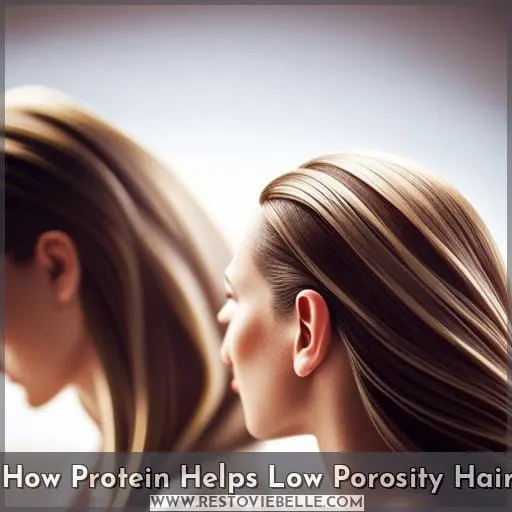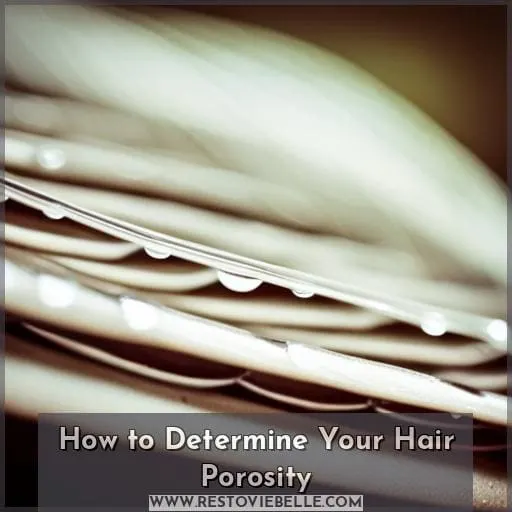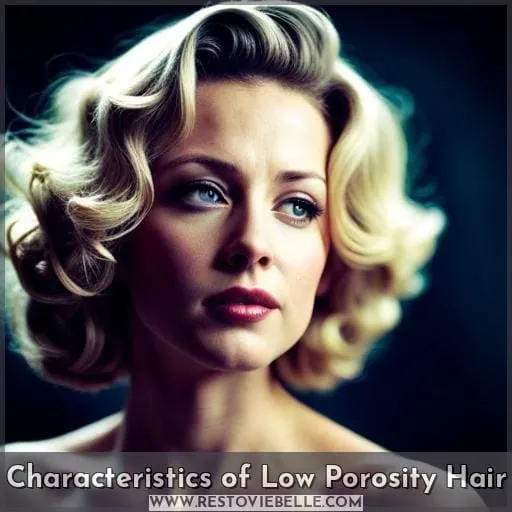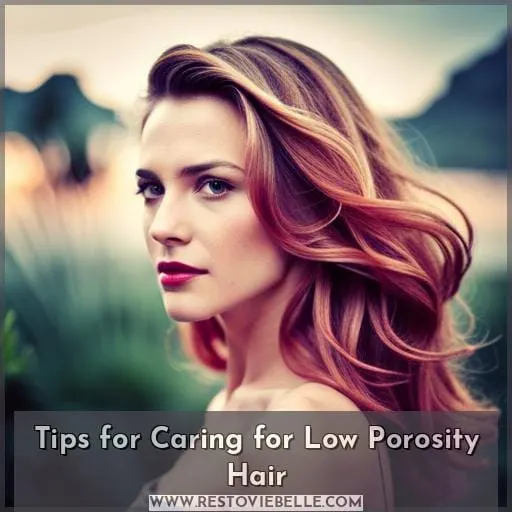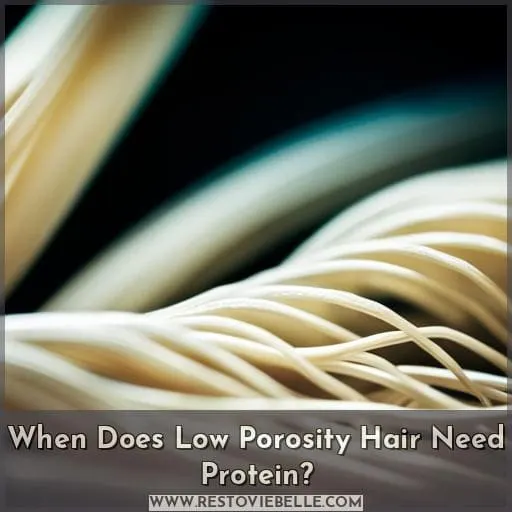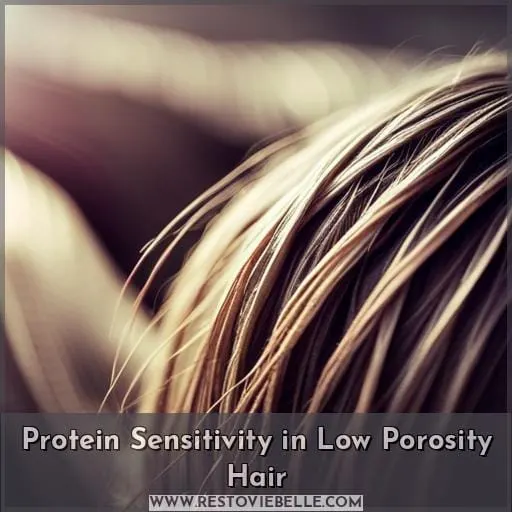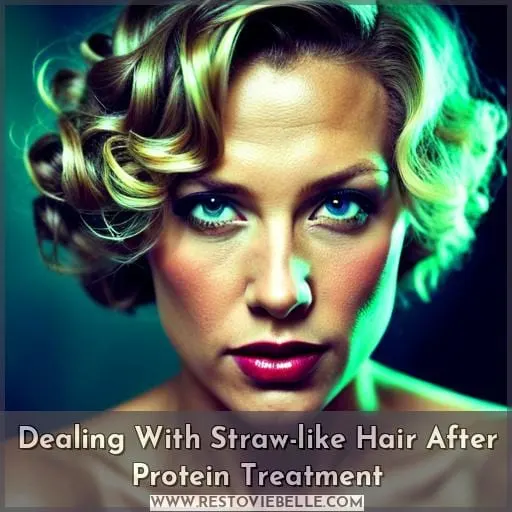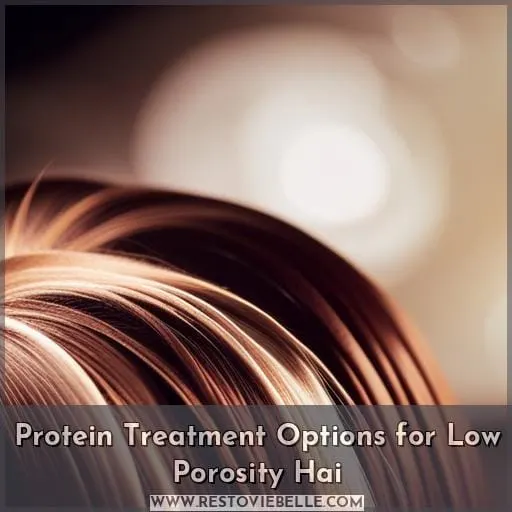This site is supported by our readers. We may earn a commission, at no cost to you, if you purchase through links.
 Imagine finally finding the secret to unlocking the full potential of your low porosity hair.
Imagine finally finding the secret to unlocking the full potential of your low porosity hair.
Say goodbye to frizz, dryness, and lackluster curls.
With protein treatments specially designed for low porosity strands, you can:
- Restore elasticity
- Reduce breakage
- Promote healthy growth
Discover the signs that indicate your hair is craving protein and learn about its incredible benefits for low porosity locks.
Get ready to embrace a world of bouncy, vibrant curls that will leave you feeling confident and empowered in your hair journey.
Table Of Contents
- Key Takeaways
- Does Low Porosity Hair Need Protein?
- Signs of Protein Needs in Low Porosity Hair
- How Protein Helps Low Porosity Hair
- How to Determine Your Hair Porosity
- Characteristics of Low Porosity Hair
- Tips for Caring for Low Porosity Hair
- When Does Low Porosity Hair Need Protein?
- Protein Sensitivity in Low Porosity Hair
- Dealing With Straw-like Hair After Protein Treatment
- Protein Treatment Options for Low Porosity Hai
- Frequently Asked Questions (FAQs)
- Can low porosity hair benefit from protein if it is already healthy?
- What are the common reasons for protein sensitivity in low porosity hair?
- What should I do if my low porosity hair feels like straw after using protein?
- Are DIY protein treatments recommended for low porosity hair?
- What type of protein treatment is best for low porosity hair?
- Conclusion
Key Takeaways
- Signs indicating low porosity hair needs protein: lack of elasticity and bounce, excessive frizz and flyaways, difficulty absorbing moisture, product buildup and residue, brittle and weak strands.
- Protein helps low porosity hair by restoring elasticity and bounce, reducing frizz and flyaways, improving moisture absorption, removing product buildup and residue, and strengthening hair strands.
- Protein is more effective than other hair treatments like deep conditioner, heat styling, moisture alone, oils, and coconut oil in repairing damage, reducing frizz, and improving moisture retention.
- Determining hair porosity can be done through quizzes or tests, observing how the strand reacts in water, or using a hair porosity chart for classification.
Does Low Porosity Hair Need Protein?
If you have low porosity hair, you may be wondering if your hair needs protein. The answer is that it depends on the condition of your hair.
Low porosity hair has tightly closed cuticles which makes it difficult for moisture and products to penetrate. This can lead to buildup and lack of hydration in the strands. Protein treatments can help improve the health of low porosity hair by strengthening the strands and promoting moisture absorption.
However, it’s important to note that not all low porosity hair will benefit from protein treatments. Some individuals with low porosity hair may actually be sensitive to protein or experience protein overload if they use too much protein in their routine.
To determine whether your low porosity hair needs protein:
Signs of Protein Needs in Low Porosity Hair
If you have low porosity hair, there are several signs that indicate your hair may need protein.
These signs include:
- A lack of elasticity and bounce
- Excessive frizz and flyaways
- Difficulty absorbing moisture
- Product buildup and residue
- Brittle and weak strands
- Slow hair growth
Recognizing these signs can help you determine if incorporating protein-rich products into your routine could benefit the health of your low porosity hair.
Lack of Elasticity and Bounce
To determine if your low porosity hair needs protein, look for signs such as:
- A lack of elasticity
- A lack of bounce
Protein treatments can help restore the flexibility and vitality of your hair strands, giving them the necessary bounce they need to look healthy and vibrant.
Excessive Frizz and Flyaways
Excessive frizz and flyaways are clear indicators that your low porosity hair is in need of protein.
Protein treatments can help repair damage, reduce frizz, and provide moisture to your hair strands for a healthier appearance.
Difficulty Absorbing Moisture
When you have low porosity hair, one of the signs that indicate a need for protein is difficulty absorbing moisture.
Protein treatments can help improve moisture absorption and restore balance to your hair.
Product Buildup and Residue
If you notice product buildup and residue in your low porosity hair, it may be a sign that your hair is in need of protein.
Protein treatments can help remove the buildup and restore the health of your hair, improving its elasticity and reducing frizz.
Brittle and Weak Strands
If your low porosity hair has become brittle and weak, it’s a clear sign that it needs protein to restore strength and resilience.
Protein treatments are essential for damaged hair, promoting healthy growth and improving overall hair texture.
Slow Hair Growth
If you notice slow hair growth in your low porosity hair, it may be a sign that your hair needs protein.
Incorporating protein masks, treatments, supplements, and foods can help promote healthy hair growth.
How Protein Helps Low Porosity Hair
Protein plays a crucial role in helping low porosity hair regain its health and vitality.
By restoring elasticity and bounce, reducing frizz and flyaways, improving moisture absorption, removing product buildup, strengthening hair strands, and promoting healthy hair growth protein can address the specific needs of low porosity hair.
Incorporating protein-rich products into your routine can help revitalize your locks and enhance their overall appearance.
Restoring Elasticity and Bounce
To restore elasticity and bounce in your low porosity hair, protein can be incredibly beneficial.
Protein helps to:
- Reduce frizz and flyaways
- Improve moisture absorption
- Remove product buildup and residue
- Strengthen your hair strands for healthy growth
Reducing Frizz and Flyaways
Protein helps in reducing frizz and flyaways, giving your low porosity hair a smoother and more polished appearance.
When comparing protein to deep conditioner, heat styling, moisture, oils, and coconut oil; protein proves to be beneficial for managing frizz and flyaways.
| Protein vs. | Reduction of Frizz & Flyaways |
|---|---|
| Deep Conditioner | Both provide moisturization but only protein strengthens the hair strands which helps reduce frizz and flyaways. |
| Heat Styling | Heat styling can cause damage leading to increased frizz and flyaways whereas protein repairs the damage making them less noticeable. |
| Moisture | Moisture alone may not be enough to combat excessive dryness that contributes to frizzy hair; adding proteins improves moisture retention resulting in reduced frizziness. |
| Oils | While oils provide nourishment they don’t have the ability to repair damaged cuticles like proteins do hence limited reduction in frizzy appearance is achieved with just oils. |
| Coconut Oil | Adding coconut oil provides some level of hydration but it lacks essential amino acids needed for repairing damaged strands thus reducing flyways moderately compared with using proteins. |
By incorporating products rich in proteins into your routine you can effectively manage both frizziness as well as those pesky little hairs that seem impossible
to tame or get rid off1
Improving Moisture Absorption
When it comes to improving moisture absorption in low porosity hair, protein plays a crucial role by helping your strands better retain and utilize hydration.
- Protein treatments for low porosity hair
- Using protein-free products for low porosity hair
- Preventing protein overload in low porosity hair
Removing Product Buildup
By incorporating protein into your hair care routine, you can effectively remove product buildup in low porosity hair.
Using clarifying shampoos or treatments can help to cleanse and clarify the hair, removing excess oils and residues for a fresh and clean scalp.
Strengthening Hair Strands
To strengthen your low porosity hair strands, incorporate protein-rich products into your hair care routine.
Protein strengthens hair, reduces frizz, improves shine, prevents breakage, and increases elasticity for healthier and more resilient locks.
Promoting Healthy Hair Growth
Protein helps to promote healthy hair growth in low porosity hair.
It restores hair elasticity, strengthens strands, and improves moisture absorption.
Protein also enhances the shine and overall health of your hair.
How to Determine Your Hair Porosity
To determine your hair porosity, you can easily perform a simple test at home. Understanding your hair porosity is essential for choosing the right products and creating an effective hair care routine.
- Porosity Quiz: Take a quick online quiz or questionnaire that asks about specific characteristics of your hair, such as its response to water and products.
- Porosity Test:
- Fill a glass with water and gently place a clean strand of dry hair into the glass.
- Observe how quickly it sinks or floats:
- High Porosity Hair: If the strand sinks immediately, you have high porosity hair.
- Low Porosity Hair: If the strand remains on top of the water without sinking for several minutes, you have low porosity hair.
- Medium/Normal Porosity Hair: If the strand sinks slowly but remains in the middle of the glass for several seconds you have medium/normal porosity hair.
- Hair Porosity Chart:
- Use a hair porosity chart to classify your hair into one of the three categories as per the test results. The chart will provide you with a detailed explanation of each point and help you understand your hair porosity type.
Determining your hair porosity is important for choosing the right products and developing an effective hair care routine. By nailing down your hair porosity more accurately, you can give your hair what it needs and achieve healthy, happy locks.
This helps in optimal moisture retention, better absorption of products, and maintaining the natural beauty of your hairstyle. So, take the time to do a at-home porosity test and gain a powerful understanding of your hair.
Characteristics of Low Porosity Hair
If you have low porosity hair, there are certain characteristics that you may notice:
- Limited product absorption, meaning that your hair has difficulty absorbing and benefiting from moisturizing products.
- Wetting your hair can be a challenge as it tends to repel water rather than absorb it.
- Low porosity hair often has a limited response to protein treatments, making it important to choose the right type of protein for this specific texture.
Limited Product Absorption
If you have low porosity hair, you may notice limited absorption of products. This can be frustrating because it means that your hair doesn’t easily soak up the moisturizing benefits of your favorite products.
Factors such as hard water and protein overload can contribute to this issue.
To combat limited product absorption, it’s important to choose lightweight, protein-free products that won’t weigh down your strands. Additionally, incorporating regular deep conditioning treatments can help moisturize and nourish low porosity hair for improved overall health and increased elasticity.
Difficult to Wet Hair
Having difficulty getting your low porosity hair wet? This is a common characteristic of low porosity hair, which can make it challenging to properly hydrate and moisturize.
Here are some signs that you may have difficult-to-wet hair:
- Dryness: Low porosity hair tends to be dry and lacks natural moisture.
- Hard to detangle: The lack of moisture makes the strands prone to tangling and knotting.
- Limited absorption: The cuticles of low porosity hair are tightly closed, making it harder for water or products to penetrate.
- Reduced elasticity: Low porosity hair often lacks flexibility and bounce.
To address these issues, incorporating protein treatments into your routine can help improve the overall health and manageability of your dry, hard-to-detangle low porosity locks. Protein helps restore elasticity, strengthen the strands, reduce frizz caused by excess moisture absorption problems in this type like limited response due their reduced ability absorb proteins from treatments they benefit less than other types from them.
By understanding your specific needs based on factors such as hair’s porosity and texture, you can choose products that complement your low porosity hair type for optimal results in hydration and detangling efforts.
Limited Response to Protein Treatments
Low porosity hair often has a limited response to protein treatments, making it important to understand how this characteristic can impact the effectiveness of these treatments.
Protein overload can occur if low porosity hair is unable to effectively absorb and utilize proteins, leading to potential damage and lack of desired results.
It’s recommended for individuals with low porosity hair to opt for protein-free products or carefully select protein treatments that are specifically formulated for their unique hair texture and needs.
Tips for Caring for Low Porosity Hair
To properly care for low porosity hair, there are a few key tips to keep in mind:
First, using products specifically formulated for low porosity hair can help provide the right level of moisture without weighing down the strands.
Additionally, moisturizing low porosity hair regularly is crucial to prevent dryness and breakage.
Applying products in sections ensures even distribution and better absorption into the hair shafts.
Incorporating steam treatments can also help open up the cuticles and enhance product penetration.
Lastly, using humectants like glycerin or honey can aid in hydrating low porosity hair by attracting moisture from the environment.
Using Products Specifically for Low Porosity Hair
When caring for low porosity hair, it’s important to use:
- Gentle, moisturizing products specifically designed for this hair type.
- Avoid heavy oils.
- Opt for protein-free products.
Incorporate deep conditioning and weekly hair masks to keep your low porosity hair hydrated and healthy.
Moisturizing Low Porosity Hair
To properly care for low porosity hair, you’ll need to focus on moisturizing it effectively.
- Use a deep conditioner or leave-in conditioner.
- Apply oils, butters, and creams to seal in moisture.
- Incorporate water-based protein treatments to strengthen your strands.
- Use gentle cleansing shampoos that won’t strip away natural oils.
- Protect your hair from heat damage with a heat protectant and use styling products that nourish and hydrate.
Applying Products in Sections
To ensure proper product distribution and maximum absorption, divide your low porosity hair into sections when applying products.
Start by determining the appropriate section size based on the thickness of your hair.
Apply products in a specific order, starting with leave-in conditioners or moisturizers followed by styling products.
Use an adequate amount of product for each section to ensure thorough coverage without weighing down the hair.
Time your application carefully to allow enough time for the product to penetrate and work its magic before moving on to the next section.
When rinsing out products, use a gentle method like finger detangling or using a wide-toothed comb while under running water for better control over how much product is being removed from each section.
Incorporating Steam Treatments
To incorporate steam treatments into your low porosity hair care routine, start by:
- Preparing a warm towel or using a steamer.
- Applying the heat to your hair for about 15-20 minutes, once every two weeks.
Be cautious not to overdo it with heat and ensure that you maintain a safe distance from the steamer or towel.
Using Humectants to Hydrate Hair
Use humectants to hydrate your low porosity hair effectively.
Humectants are substances that attract and retain moisture, making them perfect for combating dryness in curly hair.
Some common humectants include glycerin, honey, aloe vera, and panthenol.
Apply them to damp or wet hair for best results.
When Does Low Porosity Hair Need Protein?
If you have low porosity hair, you may be wondering when your hair needs protein. Understanding the signs of protein deficiency in low porosity hair can help determine if it’s time to incorporate protein treatments into your routine.
- Breakage at the ends or loss of elasticity:
If you notice frequent breakage or a lack of bounce and flexibility in your strands, it could be a sign that your low porosity hair is lacking sufficient levels of proteins.
- Color-treated or damaged hair:
Chemical processes like coloring or excessive heat styling can strip away essential proteins from the hair shafts, leaving them weak and brittle. Protein treatments can help repair and strengthen these damaged strands.
- Serious breakage:
If you’re experiencing significant breakage throughout your entire head of low porosity hair, this could indicate an overall lack of strength and resilience within the strands – another clear indication that additional protein is needed.
By addressing these signs promptly with appropriate protein-rich products such as hydrolyzed proteins designed specifically for low-porosity locks, you can replenish vital nutrients to restore health and vitality to dry or damaged tresses while promoting healthy growth1
Protein Sensitivity in Low Porosity Hair
If you have low porosity hair, it’s important to be aware of protein sensitivity.
Overuse of protein conditioners can lead to limited binding of additional proteins, resulting in straw-like hair or buildup.
It’s crucial to find the right balance and use protein treatments that are specifically formulated for low porosity hair to avoid any negative effects.
Overuse of Protein Conditioners
If you have been using protein conditioners excessively, low porosity hair can become sensitive to proteins. Overuse of protein products can lead to protein overload in the hair, causing it to become dry and brittle.
This is because low porosity hair already contains an abundance of keratin protein, making it more prone to becoming overwhelmed with additional proteins.
It’s important to strike a balance when incorporating protein treatments into your hair care routine for low porosity hair. Be mindful of the signs of excess protein such as straw-like texture and lack of moisture absorption, as these indicate a potential deficiency rather than a need for more proteins.
| Effects | Protein Overload | Protein Deficiency |
|---|---|---|
| Signs | Dry and brittle strands | Lackluster and weak-looking |
| Difficulty retaining moisture | Matted or tangled |
By understanding how your low porosity hair reacts to different levels of proteins, you can ensure that your routine meets its specific needs without causing further damage or imbalances in the structure and healthiness1
Limited Binding of Additional Proteins
You may find that your low porosity hair has limited binding of additional proteins.
Low porosity hair, characterized by tightly closed cuticle scales on the hair shaft, can have difficulty absorbing and retaining moisture. The same applies to proteins, which are essential for repairing damage and strengthening the hair bonds.
Due to the compact nature of low porosity hair, it doesn’t easily allow additional proteins to bind to its surface compared to other types of porous or damaged hair.
However, if your low porosity strands are damaged or color-treated, incorporating protein treatments can be beneficial for repair and restoration purposes.
Dealing With Straw-like Hair After Protein Treatment
If after a protein treatment your low porosity hair feels like straw, you’ve likely:
- Overused protein
- Have buildup on your hair
- Haven’t properly hydrated it.
Look into adjusting your protein treatments, clarifying your hair to remove buildup, and focusing on hydrating your strands thoroughly.
Getting the balance right between protein and moisture is key to avoiding that stiff, straw-like feeling.
Possible Overuse of Protein
When dealing with straw-like hair after protein treatment, it’s important to consider the possibility of overuse of protein.
Protein overload can occur when too much protein is applied to low porosity hair, causing it to become stiff and brittle.
It’s essential to find a balance in your hair care routine by incorporating both protein treatments and moisturizing products that cater specifically to your low porosity hair type.
Buildup on the Hair
Excessive buildup on the hair can lead to straw-like texture and appearance after a protein treatment.
It’s important to find a balance between nourishing your low porosity hair with protein and avoiding product buildup.
When there’s an overabundance of proteins, it can result in protein overload, causing the hair to become dry and brittle.
On the other hand, if there isn’t enough protein in your routine, you may experience signs of protein deficiency such as weak strands and slow growth.
Understanding your hair’s sensitivity to proteins will help you determine how often you should incorporate them into your regimen while also considering other factors like moisturizing techniques using humectants for optimal results.
Lack of Hydration
After undergoing a protein treatment, if your low porosity hair feels dry and straw-like, it may be due to inadequate hydration.
- Incorporate hydrating techniques such as deep conditioning with water-based products.
- Use humectants like glycerin or aloe vera to attract and retain moisture in your hair.
- Hydrate your hair regularly by misting it with water or using a leave-in conditioner.
Protein Treatment Options for Low Porosity Hai
To treat low porosity hair, you have various protein treatment options available. While some products on the market may contain proteins, it’s important to note that low porosity hair can be sensitive to protein.
However, there are alternative ways to incorporate protein into your hair care routine without causing any adverse effects.
One option for adding protein to your low porosity hair is through DIY alternatives. You can create homemade treatments using ingredients such as yogurt or avocado, which are rich in natural proteins and beneficial for moisturizing and strengthening the strands.
These DIY treatments allow you to control the amount of protein added and customize them based on your specific needs.
Another strategy for maintaining a moisture balance in low porosity hair while still benefiting from proteins is by opting for products that are free of added proteins but contain other hydrating ingredients like hyaluronic acid or glycerin.
This way, you can provide much-needed hydration while avoiding potential issues with excessive protein buildup.
In addition to incorporating these different treatment options into your routine, it’s essential also pay attention styling techniques that promote moisture retention in low porosity hair. Use gentle heat during deep conditioning sessions or try incorporating steam treatments which help open up the cuticles allowing better absorption of nutrients including protein.
It’s also beneficial to apply products section by section ensuring even distribution throughout the strands. Finally, where possible, use humectants such as aloe vera gel or honey-based leave-in conditioners that attract moisture from the environment keeping your locks hydrated throughout the day.
By exploring these various methods and finding what works best for your low porosity hair, you can achieve a healthy balance of protein and moisture for your locks while enjoying the freedom and empowerment of sporting beautifully nourished tresses.
Frequently Asked Questions (FAQs)
Can low porosity hair benefit from protein if it is already healthy?
Yes, low porosity hair can benefit from protein even if it’s already healthy.
Protein helps to strengthen and nourish the hair, promoting overall health and preventing future damage.
Incorporating protein treatments into your routine can improve the resilience of your low porosity hair.
What are the common reasons for protein sensitivity in low porosity hair?
Protein sensitivity in low porosity hair can occur due to overuse of protein conditioners.
Some hair types are less likely to allow additional proteins to bind, leading to straw-like texture.
What should I do if my low porosity hair feels like straw after using protein?
If your low porosity hair feels like straw after using protein, it’s likely that you have:
- Used protein too often
- Have buildup on your hair.
Make sure to:
- Hydrate properly
- Look for rich, creamy, water-based protein treatments.
Are DIY protein treatments recommended for low porosity hair?
DIY protein treatments aren’t recommended for low porosity hair.
It’s best to look for protein treatments that are:
- Rich
- Creamy
- Water-based
- Non-oily
AtrActiva Keratin Rich Conditioner is a good option if your hair is protein sensitive.
What type of protein treatment is best for low porosity hair?
For low porosity hair, the best type of protein treatment is one that contains hydrolyzed proteins.
Avoid DIY treatments like eggs or mayonnaise.
Look for rich, creamy, water-based products that are non-oily, such as atrActiva Keratin Rich Conditioner.
Conclusion
Unlock the full potential of your low porosity hair with protein treatments designed to restore elasticity, reduce breakage, and promote healthy growth.
Say goodbye to frizz, dryness, and lackluster curls as you embrace a world of bouncy, vibrant locks.
By recognizing the signs of protein needs in low porosity hair and understanding the incredible benefits protein can provide, you can transform your hair journey.
Embrace the power of protein and experience the confidence and empowerment that comes with nourished, thriving hair.
Protein is the key to unlocking your low porosity hair’s true potential.



